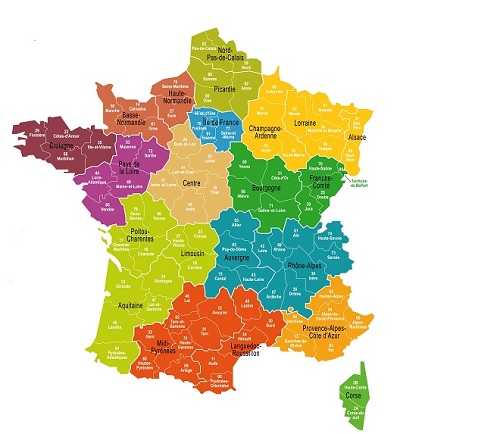The 13 New Regions of France
Wednesday 07 January 2015
The French Parliament has finally decided on a new administrative map for the country, reducing from 22 to 13 the number of regional councils.
It is an architecture with a budget of €250 billion a year, and the overlapping powers and responsibilities of the councils inevitably means that no-one really understands who is responsible for what, and most of the time no-one is responsible!
Like most other aspects of public life in France, there are too many vested interests for a clean sweep to be undertaken, so change has to come around by stealth and in incremental steps - not always in the right direction.
France accounts for no less than 40% of all the parishes in Europe, and 90% of parishes have less than 2,000 inhabitants, a dwarfism that is unparalleled anywhere else in the developed world.
Over the past few years there has been some attempt at rationalisation of the parish structure, with the creation of new 'super-parishes' - communautés de communes - but the former parishes have only been reduced to a residual role, not abolished.
As a result, in many parts of France there are now four layers of local government, particularly in rural areas.
The departments have resisted abolition, despite their extinction by 2017 a clear stated objective of Prime Minister Manual Valls, when he was appointed to the position last March by President Hollande.
So now comes the turn of the regions, where there seems to be a broad consensus that the existing regional councils are not sufficiently large or powerful enough to become engines for economic growth.
Inevitably, every proposal tabled by the government has had its strong dissenters, but in the end the parliamentarians have agreed to a rationalisation of the existing structure, reducing from 22 to 13 the number of regions.
The new regions will be created from the merger of existing regions, as follows:
- Alsace, Champagne-Ardenne and Lorraine
- Aquitaine, Limousin and Poitou-Charentes
- Auvergne and Rhône-Alpes
- Burgundy and France-Comté
- Languedoc-Roussillon and Midi-Pyrénées
- Nord-Pas-de-Calais and Picardy
- Lower Normandy and Upper Normandy
The regions of Brittany, Pays de la Loire, Provence-Alpes-Côte d’Azur Corsica, and Ile-de-France will maintain their existing boundaries, although it can be anticipated that a merger between Brittany and the Pays de la Loire is likely happen at some point in the future. Only political cronyism kept it from being wrapped together in this round.
The names for the new regions have not yet been decided, and until 2016 at the earliest it is proposed to use quick fixes, borne of the juxtaposition of the existing names. The only exception to this rule will be Lower and Upper Normandy, which will merely drop the prefix to become Normandy.
Also to be determined is the capital for each of the new regions. The only one that is presently clear is that Strasbourg will be entrusted as the centre for Alsace, Champagne-Ardenne and Lorraine. Lyon will probably become the capital of the new region of Auvergne and Rhône-Alpes and Toulouse the capital of Languedoc-Roussillon and Midi-Pyrénées, with Bordeaux picking up Aquitaine, Limousin and Poitou-Charentes.
Elsewhere is it not so clear cut. Both Caen and Rouen both have strong claims to become the capital of Normandy, and Dijon and Besançon are fighting it out for the seat of Burgundy and France-Comté.
Also yet to be determined is the division of powers and responsibilities between the regions and departments, a topic that is being hotly debated. The departments are resisting the transfer of secondary education and highways to the regions, as well as demanding a continuing residual responsibility in relation to economic development.
Despite the administrative reorganisation, the political structure remains the same, with no change in the number of regional councillors. Perhaps that was the price to pay for agreement on change.
It is as yet unclear whether there exists a chamber in which they can also sit, or whether new regional seats of government will need to be constructed.
A number of parliamentarians (primarily from Alsace), have referred the law to the Constitutional Council, claiming that the changes have been made without proper consultation with the local councils. It may yet all implode!

Related Reading:
Next Article: Autoentrepreneur Changes 2015
Thank you for showing an interest in our News section.
Our News section is no longer being published although our catalogue of articles remains in place.
If you found our News useful, please have a look at France Insider, our subscription based News service with in-depth analysis, or our authoritative Guides to France.
If you require advice and assistance with the purchase of French property and moving to France, then take a look at the France Insider Property Clinic.





